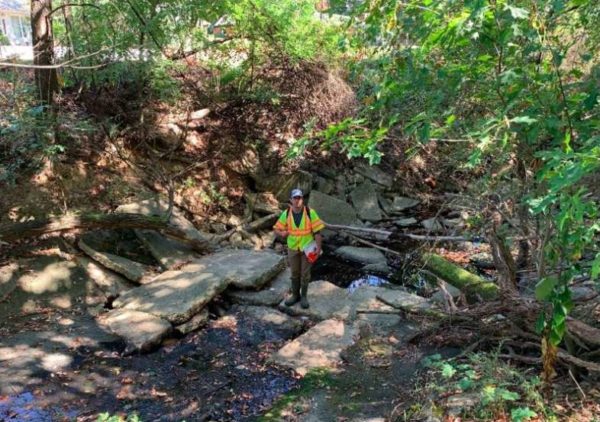Near the end of a nearly eight-hour meeting, the City Council opted last night to send aspects of the city’s controversial stream restoration projects back to the drawing board in light of widespread public criticism.
Stream restoration became something of a surprise Seminary Road-like issue last year. Many recurring public complaints — namely over a lack of communication from staff and concerns regarding city studies — resurfaced during the Taylor Run and Strawberry Run stream restoration debates.
But in other ways, the coalition uniting against the city’s plans for Taylor Run and Strawberry Run looked different from the Seminary Road debate. While the same elements that composed to Seminary Road diet opposition were present in the stream restoration debates — local civic associations and the Bring Integrity Back to Alexandria! group — they were joined by more unexpected sources of dissent, like Audubon Society of Northern Virginia and the Alexandria Environmental Policy Commission (EPC).
“This has evolved into a political issue, but I’m here to voice my opinion on the science,” said EPC member Marta Schantz. “We’re concerned that many questions about current approach and good faith exploration of alternatives remains unanswered.”
At the City Council meeting, the EPC laid out several concerns that had been repeated by some environmentalists throughout the process — with staff reiterating many earlier responses.
It’s a muddy, tangled issue with branching concerns over the efficiency of natural channel design, the impact on wildlife in the area and the impacts of erosion — but one of the fundamental issues considered by City Council at the meeting was whether or not the stream is as polluted as the city’s modeling indicates.
Critics of the project, including the city’s Natural Resource Manager Rod Simmons, say the city is calculating pollution levels in the stream not based on first hand evidence gathering, but rather on state-approved models based on studies done in Pennsylvania. A study by Simmons found significantly lower levels of phosphates in Taylor Run, though Simmons’ study was criticized by the city as not providing a complete view of total phosphate levels in the water.
Complicating matters is the city’s plans to have the stream restoration work count towards the city’s required pollution reduction credits. Staff reiterated that alternatives to stream restoration could be more expensive, less beneficial to the city — like paying credits for an equivalent amount of pollution reduction — and result in fees passed on to tax payers.
Even then, staff said the city will likely eventually need to take some form of action to prevent homes new Strawberry Run and Taylor Run from being threatened by erosion.
“If we take approach that we don’t need to do anything, we risk losing grants, we pay for credits, and we’ll eventually need to do something to protect neighboring homes from erosion,” said Matt Landes, project director for the Department of Project Implementation.
City staff said there’s a looming deadline to meet pollution reduction guidelines laid out by the Virginia Department of Environmental Quality. Staff said that to meet a June 2022 deadline, the stream restoration projects need to move into final design in the May/June timeframe and the project needs to move into procurement by December this year.
Testing Taylor Run’s water for phosphates, staff said, could take two-to-three months to get reliable results. But the city council — led by urging from members Amy Jackson and John Chapman — agreed to take that time to do the studies and get a better picture of the pollutant levels in Taylor Run and Strawberry Run.
“It’s disconcerting to a lot of community members tonight,” said Jackson. “We usually don’t have public comment except for public hearings. They’ve been here pretty much every time signing in to discuss what they think is important… to be continually, what I feel: shoved aside.”
The Environmental Council of Alexandria, which is led by former Vice Mayor Andrew Macdonald, has been the city’s main opponent to the project.
“Staff reports and responses from City staff indicate that they want to proceed with this destructive and ineffective project despite all the scientific evidence against doing so,” ECA wrote on Facebook on April 23. “This may be our last chance to stop this environmentally unsound project.”
Chapman said the city should also take those months to get a better look at alternatives to current stream restoration plans.
“We need to take a good look at alternatives,” Chapman said, “and not just the ones presented here.”
While Strawberry Run and Taylor Run took the lion’s share of the conversation, Mayor Justin Wilson said it would be willful ignorance on the city’s part to go forward with testing those without getting a more accurate idea about pollutant levels in Lucky Run, also slated for restoration work.
“I have a hard time justifying how Lucky Run is okay but Taylor Run and Strawberry Run aren’t,” Wilson said. “[We’re] not sampling Lucky Run… because we don’t want to know what the answer is.”
In response, the Council agreed to also loop Lucky Run in with planned testing of the other stream sites. The City Council directed staff to come back at a later date to lay out more community engagement and a timeline for further study of the streams.
Photo via City of Alexandria
"and" - Google News
April 29, 2021 at 03:45AM
https://ift.tt/3t3fS6e
Stopping Midstream: City Council sends Taylor Run and Strawberry Run Stream projects back for further study - ALXnow
"and" - Google News
https://ift.tt/35sHtDV
https://ift.tt/2ycZSIP
And
Bagikan Berita Ini















0 Response to "Stopping Midstream: City Council sends Taylor Run and Strawberry Run Stream projects back for further study - ALXnow"
Post a Comment